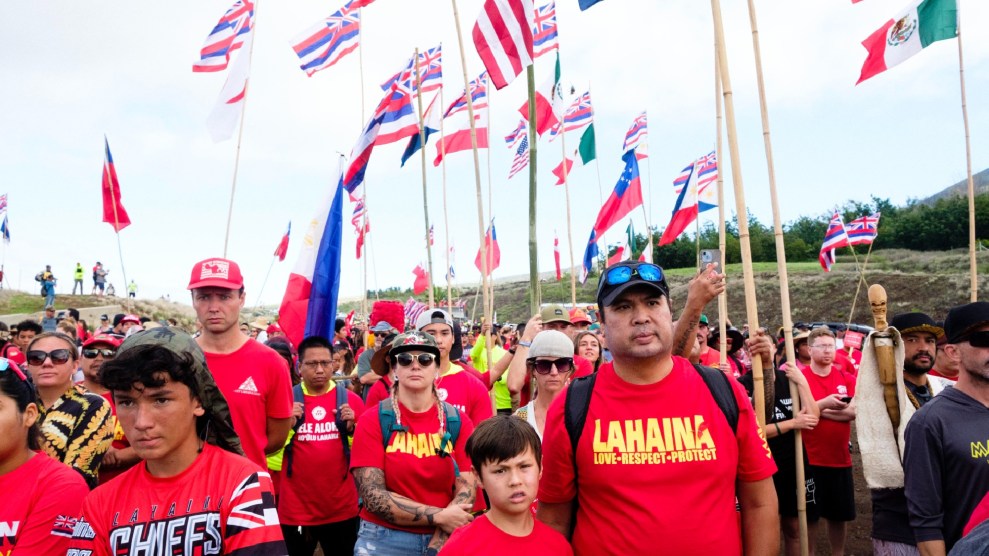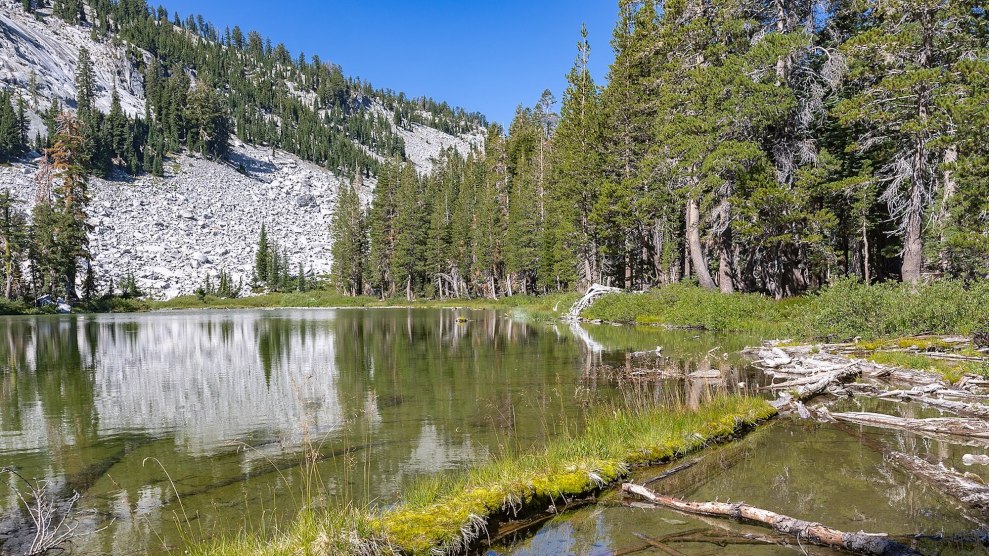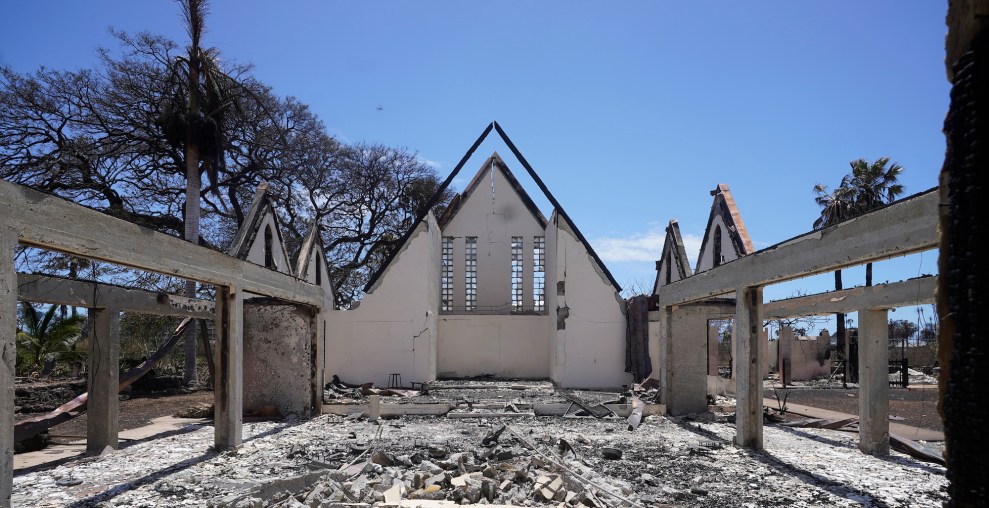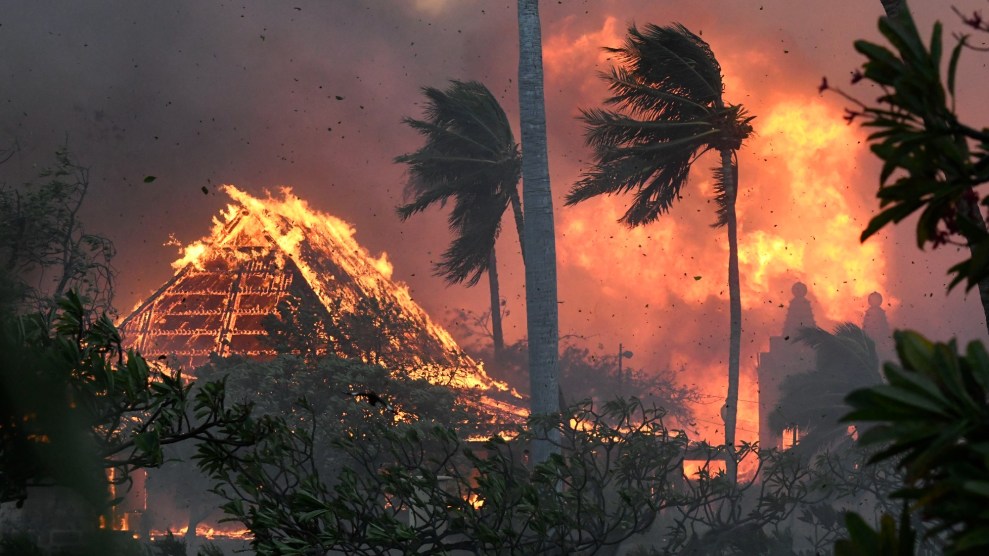
Local Maui residents march in support of Lahaina's recovery from the 2023 wildfire. J. Matt/ZUMA Press Wire
This story was originally published by Grist and is reproduced here as part of the Climate Desk collaboration.
The one-story home 100 yards from Lāhainā Harbor where Tiare Lawrence grew up was a typical Hawaiʻi plantation home, a historic architectural style with a wide-hipped roof, a wooden light blue exterior, and a purple bougainvillea bush in the front yard.
It’s where her grandmother grew up, and her mother and aunties and uncles too. For more than a century, her family held onto the home, even as the number of Native Hawaiian families in Lāhainā dwindled, property taxes rose, and the town around them morphed into a tourism hub. In high school, Lawrence would wake up at dawn before school and carry her surfboard from the carport to her favorite surf spot, paddling as the sun’s rays softly lightened the West Maui sky.
Her voice breaks when she talks about it now: the banana patch her grand-uncle tended, the countless family gatherings, the family photos now lost forever after the house burned in a vicious wildfire last summer.
Thursday will mark one year since a wildfire ripped through Lāhainā, killing more than 100 people in the deadliest wildfire in modern United States history. The violent inferno devastated the coastal community, burning more than 2,000 buildings and displacing thousands of residents. This week, the community has scheduled many events to commemorate the disaster: surfers will paddle out en masse, families will gather at the Lāhainā Civic Center, and more than 100 Kānaka Maoli sixth graders will put on a stage production to honor the history of the town, once the capital of the Hawaiian Kingdom.
The anniversary comes on the heels of a $4.037 billion tentative settlement announced Friday. In the wake of the fires, victims filed hundreds of lawsuits against the utility believed to have sparked the fire and the landowners whose dry grasslands served as ready fuel. Settlement talks were delayed in part due to a fight over who should get paid first, the victims or insurance companies. More than 100 insurers filed lawsuits to recoup billions they’ve already paid out.
“We have one shot to do this right,” the organizations posted on social media. “And while individual cash payouts are crucial to the immediate relief of many, they donʻt get us much closer to that collective objective.”
That issue still hadn’t been resolved when Hawaiʻi Gov. Josh Green announced Friday that the parties had reached a proposed settlement. The bulk of the money—$1.99 billion—will come from Hawaiian Electric, an amount that’s expected to enable the utility to avoid bankruptcy. It’s not yet clear how the rest of the funding will be split up amongst other defendants, which include the State of Hawaiʻi and Maui County as well as private entities. Insurers have 90 days to resolve their claims in the wake of the tentative agreement.
So there are still many unanswered questions about when Maui residents will actually get their money, and how the funding would be split amongst survivors, attorneys, and insurance companies. But once those questions are answered, the settlement could be a crucial boost to displaced families and a remarkably quick conclusion to litigation that elsewhere has dragged on for years.
It would also be yet another data point underscoring the high cost of wildfire disasters, which are expected to grow more frequent as climate change worsens. Last year, PacifiCorp agreed to pay $299 million to victims of the 2020 Archie Creek fire in Oregon, with plaintiffs receiving an average of $646,000 each. In California, Pacific Gas and Electric settled claims related to the deadly Camp Fire that killed 85 people for $13.5 billion as part of their bankruptcy case.
On the West Coast, the pattern of devastation followed by lawsuits and large settlements has become a familiar cadence, one that’s been criticized for its lack of effectiveness in making victims whole. Sometimes, recipients see big tax bills that cut into needed payouts. Others argue the litigation is merely a Band-Aid on the underlying problem of climate change, allowing the federal government—it generally isn’t a defendant—to continue to duck its role in facilitating fossil fuel emissions.
In Hawaiʻi, grassroots organizations are concerned that individual settlements will fall short of addressing the expensive infrastructure improvements that are needed in order for the community to truly rebuild. Several groups like the Lāhainā Community Land Trust sent a letter to litigation parties in July urging them to consider including funding for a master-planned community and other necessities in the discussions. Four billion is a third of the $12 billion estimated overall cost of the disaster.
“We have one shot to do this right,” the organizations posted on social media. “And while individual cash payouts are crucial to the immediate relief of many, they donʻt get us much closer to that collective objective.”
Not everyone is tracking the settlement closely. Randy Dadez, whose rental home burned down in the fire, hadn’t seen last week’s headlines about a looming settlement because he’s been busy working as a shuttle driver for a West Maui hotel and taking care of his wife and four kids.
“I have zero thought about money, to be honest with you,” he said. “To be honest, money is the furthest thing from my mind.”
Instead, he’s worrying about his four kids, aged 9 through 22, and the stress they’ve been under since they became homeless in the disaster. For months they bounced around between hotels: first the Fairmont, then the Hyatt, then a long stretch in Honua Kai Resort, then the Royal Lahaina. It wasn’t until last month that the Federal Emergency Management Administration finally moved them into a house. But they’re only there until February. After that, Dadez doesn’t know what’s next.
Of course money would help, he said. His dad’s house, which had been in the family since 1938, burned down, and it didn’t have insurance. Rebuilding would be costly: home construction costs on Maui can easily run $350 per square foot, or more than half a million dollars for a 1,500-square-foot house.
But Dadez is skeptical about how far any settlement money would actually go, and is a lot more concerned with juggling his daily responsibilities, including ferrying his wife and children to and from medical appointments for migraines, scoliosis, anxiety, and various other maladies.
“All I pray for is that we have good health and I tell the Lord if there’s anything extra, it’s OK,” he said.
Lawrence, the Native Hawaiian community organizer, is also watching settlement news skeptically. She wasn’t living at her family home the day of the fire. But her grand-uncle, her sister, and her brother were all in Lāhainā and managed to escape. Lawrence has spent the past year raising money for disaster relief and coordinating community projects. She’s also watched family after family leave, moving to Oregon, Washington state, and Las Vegas. What she wants most of all is for the settlement money to go to Lāhainā families to enable them to rebuild their community. She thinks of her 82-year-old grand-uncle. He’s doing OK, but doesn’t have decades to wait.
“He, like everyone else, would rather be home,” she said.
















